Tuesday, 1 August, Moscow, life-jacket drill, touring, and folk music
Written 1 August 2017
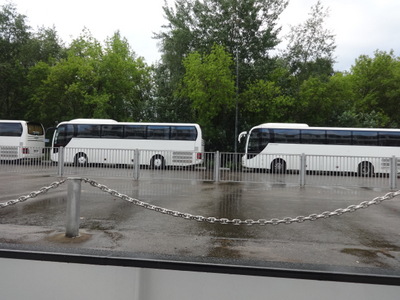
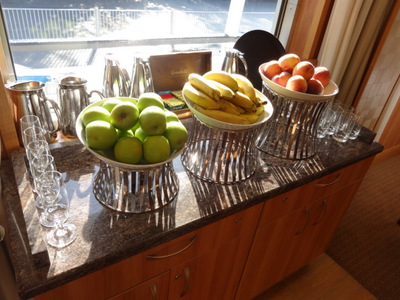 It was raining lightly when I got up but has since (at 11 a.m.) brightened up and mostly cleared. My stateroom was on the side facing the quai, so I had hoped to have a view of Moscow, but as it happened, the ship was moored almost an hour's drive from th middle of town, and in addition the quai was separated from the nearest street by a wide band of park, so this (left) is what I saw—park, a wrought-iron fence, and parked tour buses (which came and went). Occasionally, I could see picknickers through the trees, up at the level of the roofs of the buses, where ground level of the park was.
It was raining lightly when I got up but has since (at 11 a.m.) brightened up and mostly cleared. My stateroom was on the side facing the quai, so I had hoped to have a view of Moscow, but as it happened, the ship was moored almost an hour's drive from th middle of town, and in addition the quai was separated from the nearest street by a wide band of park, so this (left) is what I saw—park, a wrought-iron fence, and parked tour buses (which came and went). Occasionally, I could see picknickers through the trees, up at the level of the roofs of the buses, where ground level of the park was.
Note the fence between me and the buses. At long intervals that fence was interrupted by a permanently parked enclosed trailer housing a security checkpoint and metal detector. A security guard was usually (but not always) on duty there, looking at us as we passed through, but the detector was never turned on— we just filed up two steps, through the detector, out the other side, down two steps and then 100 yards to the ship. Going out, e.g., from the ship to our buses for an excursion, we were allowed to by-pass the trailer and just go around it through the fence.
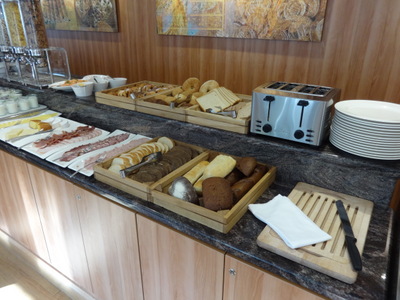
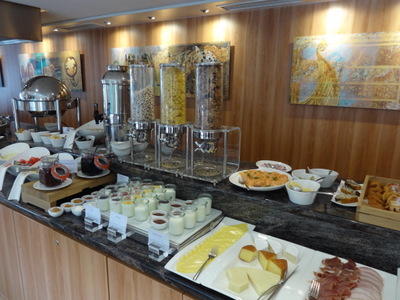 Great buffet breakfast in the dining room at 7 a.m. (or pastries and coffee from the coffee station or in the Sky Bar from 6 a.m.). Whole apples, bananas, and peaches (above). Wide variety of breads and buns (sliced and whole; pullman bread; bagels, plus a toaster); miniature viennoiseries (pain au chocolate, cocoa spirals, tiny croissants, little fruit bear-claws) and marble pound cake; platter of thick slices of smoked salmon with cream cheese, capers, red onion, pickles, and lemon wedges; cold cuts including raw ham, roast pork (or turkey?), olive loaf, and salami; three whole cheeses (camembert, a soft buttery thing with small eyes, and a smoked-looking thing) and a sliced swiss; fresh diced watermelon, pinapple, and (mirabile dictu!) canary melon; three cold cereals (yellow flakes, chocolate flakes, and cheerio-like rings) and hot oatmeal with milk and a variety of nuts and fresh and dried fruit to sprinkle on (including flax seed); fresh yogurt with and without fruit compote; two jams made on board (blueberry and raspberry, I think) plus "diet" jam; peanut butter; sliced tomatoes, bell peppers, zucchini, and onions.
Great buffet breakfast in the dining room at 7 a.m. (or pastries and coffee from the coffee station or in the Sky Bar from 6 a.m.). Whole apples, bananas, and peaches (above). Wide variety of breads and buns (sliced and whole; pullman bread; bagels, plus a toaster); miniature viennoiseries (pain au chocolate, cocoa spirals, tiny croissants, little fruit bear-claws) and marble pound cake; platter of thick slices of smoked salmon with cream cheese, capers, red onion, pickles, and lemon wedges; cold cuts including raw ham, roast pork (or turkey?), olive loaf, and salami; three whole cheeses (camembert, a soft buttery thing with small eyes, and a smoked-looking thing) and a sliced swiss; fresh diced watermelon, pinapple, and (mirabile dictu!) canary melon; three cold cereals (yellow flakes, chocolate flakes, and cheerio-like rings) and hot oatmeal with milk and a variety of nuts and fresh and dried fruit to sprinkle on (including flax seed); fresh yogurt with and without fruit compote; two jams made on board (blueberry and raspberry, I think) plus "diet" jam; peanut butter; sliced tomatoes, bell peppers, zucchini, and onions.
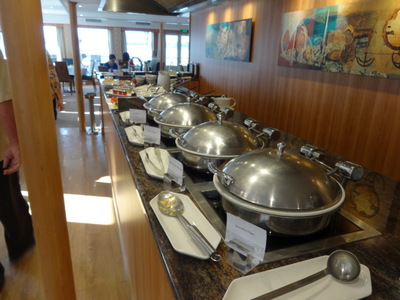
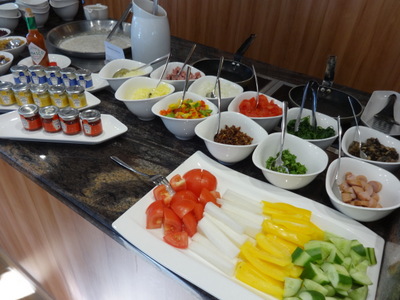 Chafing dishes of scrambled eggs (good), sausages (bad; essentially little wieners), "poultry" sausage (which I haven't tried yet), bacon, cooked mushrooms, potatoes (undercooked), and sautéed zucchini; tiny glass jars of mustard, ketchup, and mayo; and a complete, manned omelet station with many adjuvants. Orange and cranberry juices; coffee, tea, and chocolate. On the tables are orange marmalade, cherry jam, strawberry jam, honey, and butter. Yummy.
Chafing dishes of scrambled eggs (good), sausages (bad; essentially little wieners), "poultry" sausage (which I haven't tried yet), bacon, cooked mushrooms, potatoes (undercooked), and sautéed zucchini; tiny glass jars of mustard, ketchup, and mayo; and a complete, manned omelet station with many adjuvants. Orange and cranberry juices; coffee, tea, and chocolate. On the tables are orange marmalade, cherry jam, strawberry jam, honey, and butter. Yummy.
As usual, after I finished eating, I fired up the computer in the dining room and worked on this diary while I waited to see whether any of the others would show up (Ev finally stumbled in about 9 a.m.). Several people came over to ask what I was working on, and I'm told the staff are already joking that if I'm a hotel inspector, I should be a little more secretive about it!
Written 2 August 2017, crack of dawn
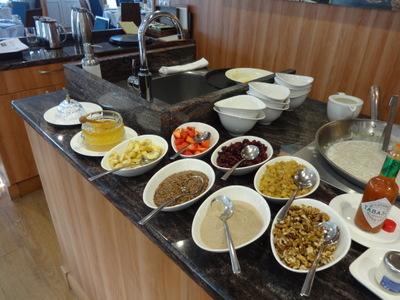
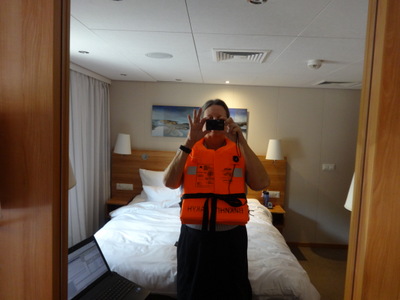 After breakfast, a leisurely morning, punctuated only by the 10 a.m. life-jacket drill. A gentle alarm (at first, I thought it was a phone ringing in the stateroom next door) signalled us to report to our cabins and don our life jackets, use of which had been demonstrated at the previous day's briefing. Then the same alarm, ringing in a pattern (indicating "abandon ship"), signalled us to stand outside our stateroom doors waiting to be inspected. It was apparently very important to tie your life jacket with a bow of only one loop (our inspector didn't have enough English to explain why). Then more leisure time until lunch.
After breakfast, a leisurely morning, punctuated only by the 10 a.m. life-jacket drill. A gentle alarm (at first, I thought it was a phone ringing in the stateroom next door) signalled us to report to our cabins and don our life jackets, use of which had been demonstrated at the previous day's briefing. Then the same alarm, ringing in a pattern (indicating "abandon ship"), signalled us to stand outside our stateroom doors waiting to be inspected. It was apparently very important to tie your life jacket with a bow of only one loop (our inspector didn't have enough English to explain why). Then more leisure time until lunch.
Written 20 August 2017
As you can deduce from the abrupt jump in "written" date, That was the last leisurely morning we had. We were busy, especially in Moscow and St. Petersburg, where we had so much to see, and of course the Viking tour guides opened the floodgates of information, so I spent every free minute for the rest of the trip scrambling to transcribe my notes from the day's tours, and I'm only now, after the trip, getting back to write it all up!]
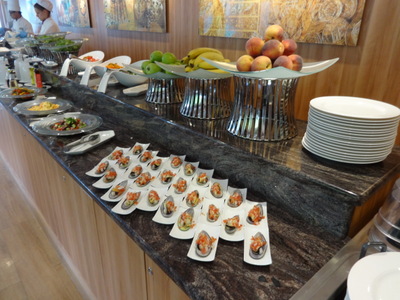
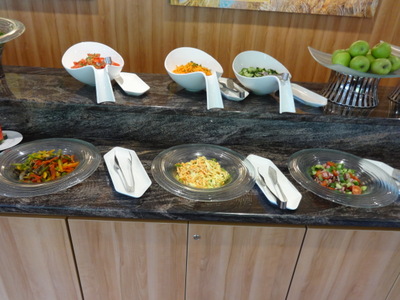 Lunch began each day with the appetizer buffet/salad bar, which featured two items listed on the menu as the official "appetizers" (on this day, huge cold green-lipped mussels topped with a vegetable salsa (on little individual plates in the foreground) and a chafing dish of braised bbq spare ribs), typically three mixed salads (here kidney beans with tomatoes, cucumber, and bits of boiled ham; carrot and cabbage slaw; and bell peppers with mushrooms) and three kinds of plain chopped vegetables (here cucumbers, carrots, and tomatoes), as well as three different bowls of chopped salad greens and fresh whole fruit.
Lunch began each day with the appetizer buffet/salad bar, which featured two items listed on the menu as the official "appetizers" (on this day, huge cold green-lipped mussels topped with a vegetable salsa (on little individual plates in the foreground) and a chafing dish of braised bbq spare ribs), typically three mixed salads (here kidney beans with tomatoes, cucumber, and bits of boiled ham; carrot and cabbage slaw; and bell peppers with mushrooms) and three kinds of plain chopped vegetables (here cucumbers, carrots, and tomatoes), as well as three different bowls of chopped salad greens and fresh whole fruit.
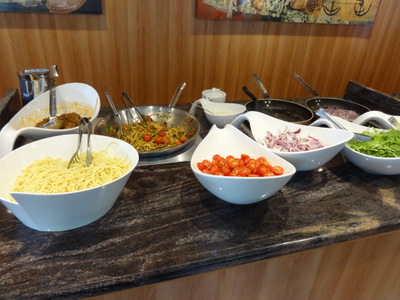
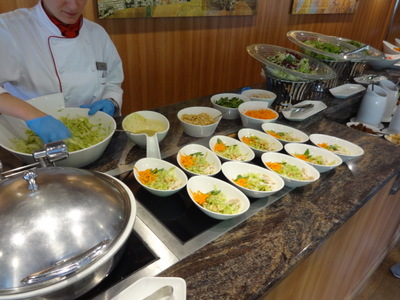 The buffet also included a pasta station featuring a different pasta dish each day (here Bolognese) and small ready-made salads (in this case with an Asia-style mix with chicken, snow peaks, lettuce, and carrots with a ginger dressing).
The buffet also included a pasta station featuring a different pasta dish each day (here Bolognese) and small ready-made salads (in this case with an Asia-style mix with chicken, snow peaks, lettuce, and carrots with a ginger dressing).
Main courses were ordered from three offered on the menu, which typically included at least one Russian specialty and a vegetarian option.
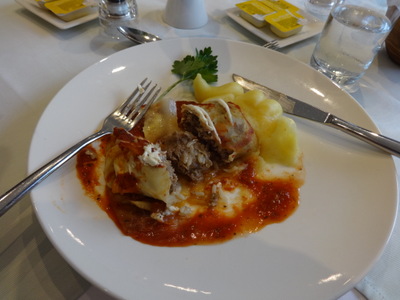
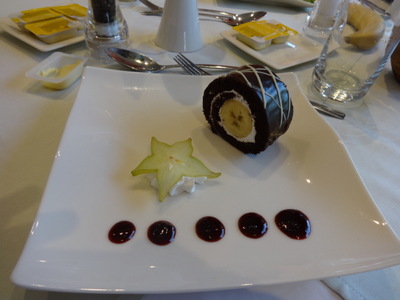 On this day Rachel and I had Traditional Russian Goluptsi (cabbage rolls stuffed with meat, braised in tomato sauce) with mashed potato. David had the pasta, and I think Ev chose the Albacore Tuna Melt, hold the onion, with radish and watermelon salad and potato chips. The other choice was lentil soup with bacon, carrots, and celery.
On this day Rachel and I had Traditional Russian Goluptsi (cabbage rolls stuffed with meat, braised in tomato sauce) with mashed potato. David had the pasta, and I think Ev chose the Albacore Tuna Melt, hold the onion, with radish and watermelon salad and potato chips. The other choice was lentil soup with bacon, carrots, and celery.
The two dessert options were chocolate-banana roulade and strawberry ice cream with mixed berry compote. I think we all chose the roulade, wich was a thin sheet of chocolate cake spread with whipped cream and rolled around a whole banana, covered with a thin chocolate glaze, and striped with white icing. It came garnished with dots of red berry compote, whipped cream, and a slice of star fruit (i.e., carambola).
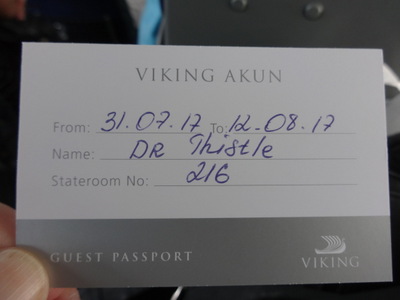
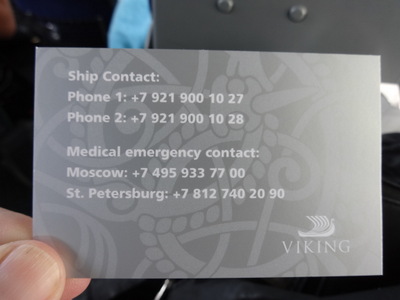 Then it was time for our afternoon tour of Red Square, the Kremlin, and Treasures of the Kremlin Armory.
Then it was time for our afternoon tour of Red Square, the Kremlin, and Treasures of the Kremlin Armory.
Whenever you leave a Viking ship for any reason, you stop at the reception desk to pick up your "guest passport," a small grey and white card with your name, stateroom, and cruise dates on one side and emergency contact numbers on the other. If you get lost, sprain your ankle, or meet with other adversity, you can then contact the ship for help. When you get back to the ship, you turn the card back in to the staff member waiting at the door to collect them. The staff then count the cards to make sure everyone expected has actually returned. (If not, they send out a search party.) They really need to find a better name for those cards, though. We also had the option to leave our passports with reception (I did, for the whole cruise) or to pick them up after the first day and keep them ourselves. Calling the cards "guest passports" caused endless confusion among those who didn't understand the system and thought they had to pick up their US passports each day. On our last cruise, they were called "boarding cards," which worked a little better.
On our 2015 cruise in Portugal, our group assignment was the same every day—we were always on bus C, with tour escort Henry—but this cruise included so many more people and so many more simultaneous options, that with our cards, we also picked up our "group assignment" for the day—a rigid plastic card telling us which bus to board (those cards were collected by that bus's tour escort as we boarded).
On this occasion, because our afternoon's excursion would be so long, we wouldn't be getting back to the ship for dinner until much later than usual, so the kitchen had packed snack boxes for us, which we picked up, along with our usual bottled water, on the way to the buses.
Because we were so far from the center of things, and because Moscow traffic is so bad, we had a long bus ride to get the tour's starting point. And because Viking didn't want us to feel the time was wasted, our tour escorts filled the time with lectures on Russian history, culture, customs, etc. The ship carried three tour escorts—Alexei, Sasha, and Vadim—and for this trip, we drew Vadim.
He started with the official founding of Moscow, in 1147, by which time it was already a small village. By the 13th century, it had become a city. The word "kremlin" means "fortress" in old Russian. Almost every Russian city has or had a kremlin, just as most western European cities had a walled fortress at one time, but now of course when the Kremlin is mentioned, everyone thinks of the one in Moscow. In the 13th century, it was the seat of government and a royal residence.
In the 13th century, Tatar Mongols, calling themselves the Golden Horde, invaded Russia and then stuck around for 200 years collecting tribute from all the Russian nobles. The first organized attempt to drive them out was in the 14th century, but it wasn't until the 15th century that a Russian noble refused to pay the tribute and made it stick. Other joined him, and the Golden Horde fell in 1480.
In those days, what is now Russia was a series of independent fiefdoms or city states, but most Russian areas were united around Moscow during the 15th century. In the 16th century, Ivan IV (aka Ivan the Terrible) adopted the title "Tsar," a word cognate with "Caesar."
In the 18th century, Peter I (aka Peter the Great), moved the capital from Moscow to St. Petersburg, where it stayed until the revolution in 1917 (which some claim actually a coup d'état, since it was perpetrated by a minority). The communists moved the capital back to Moscow in 1918.
While Stalin was alive, the Kremlin was closed to visitors. He died 1953, and was succeeded by Nikita Khruschev. Kruschev moved all the government officials and dignitaries out of their uarters in the Kremlin and into apartments and reopened the Kremlin toaw the visitors in the 1950's.
The Kremlin Armory, repository not just of arms for of all sorts of government-owned treasure, including diplomatic gifts, got its own building in the 16th century, but it was wooden and burned down. A stone building was built in the 18th century. Because the members of the first communist government were educated and cultured people, they saw the historical and cultural value of the collection and protected it from destruction during the revolution. The armory collection includes about 4000 items and is now a state museum.
During its history, Moscow has had 4 different (concentric) perimeter walls. The first, was the Kremlin wall; the second survives only in fragments; the third was replaced by a boulevard ring (in the 18th century); and the fourth was replaced by the "garden ring," a ring of houses with gardens (also in the 18th century).
In the 12th century, the Kremlin wall was pine; later it was replaced by oak, later still by limestone, and by the end of the 15th century, by brick. The Kremlin was reconstructed in the 15th century, and nother nothing there now dates from before that time.
Russia became Christian (or, as the guides said, "was baptized") in the 10th century after a prince (Vladimir of Kiev, I think) traveled to Constantinople and adopted Eastern Orthodox Christianity. First the church was centered about 10 miles east of Moscow, but the seat was later moved to Moscow.
When Turkey conquered Byzantium, Russia was left as the guardian of the eastern church. The successor of Rome was Constantinople, and Constantinople's successor was Moscow. The Metropolitan of Moscow became the Patriarch of the church. On that occasion, the Kremlin was redone again in the 19th century.
Market Square, just outside the Kremlin walls, was cleared of stalls and shops and became Red Square (in old Russian, "red" meant "beautiful"; the name has nothing to do with communism).
Under the Tatar Mongols, only small churches were built, because all the money was going to pay tribute, but after the Mongols fell, beautiful cathedrals sprang up. Russian cathedrals tend to be small iInside and to have very thick walls and tiny windows. The congregation stands throughout the several-hour-long service. Their icon stands—partitions separating the nave-equivalent from the choir-equivalent; what in Roman catholic churches of western Europe are called rood screens—are intact (unlike those in most in Roman Catholic churches). They consist of solid walls, open only at the very top and through a single door in the center, and are completely covered with religious icons, traditionally arranged in four or five horizontal tiers. The doors are only opened during services, and only the priest can pass through it to the altar. No musical instruments are used inside the church; only the choir provides music.
Religion was repressed under communism, religious freedom was restored during the reforms of the 1990's.
In answering questions or in response to interesting things we passed as we crawled toward central Moscow, Vadim told us many other things as well:
- Moscow has a Lutheran, a Baptist, and an Anglican church, 6 synagogs, 6 mosques, a couple of Roman Catholics churches.
- Russian is the state language everywhere, but areas with ethnic autonomies also have a second state language, taught in schools.
- Buildings with balconies are likely to be apartments; those without are likely to be offices.
- We were driving on the Leningradski Motorway (very slow; traffic jams, construction); the architecture was mostly 1950s, but not as slabsided and grey as we expected.
- During World War II, The Russians hung a huge canvas over the Kremlin and painted it with streets, roofs, and trees, so the German bombers couldn't find it! It must have worked, because the Kremlin suffered little damage.
- It takes 8–10 hours, depending on traffic, to drive from Moscow to St. Petersburg. Trains do the distance in 8 hours; TGVs (high-speed trains) in 3 hours. It's a one-hour flight, but if you count the time door to door, the train is faster.
- Under communism, people in the country could own and pass on houses and land, but in the cities, apartments were assigned. As long as a relative continued to live there, the apartment could stay in the family, but if the last related occupant died, the apartment reverted to the state to be reassigned. Since the reforms of the 1990's, though, people can buy, own, and hand down city apartments.
- A regulation says that a building of no more than five floors gets no elevator. Above that, you get an elevator. (That was under communism; not sure whether it's still true.)
- Under Khruschev, in response to a housing shortage, thousands of cheaply constructed apartment buildings were erected. They were exactly five floors high (no expensive elevator), had low ceilings (lower construction costs), and were constructed to last 20 years. They're still there, and still occupied, 50 years later, and are referred to as "Khruschev slums. Now a program is under way to tear down many thousands of them and to replace them with newer construction. Occupants will be assigned new apartments, free of charge, in the same area, and their children will continue at the same schools.
-
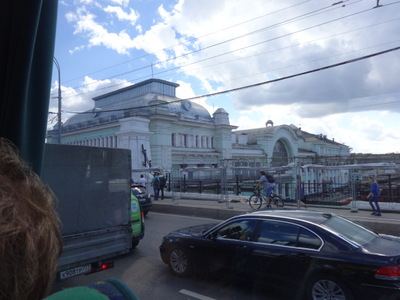 Moscow has 9 railway stations, leading, like the ones in Paris, off in different directions. We drove past the Byeloruski station, shown here at the right, several times.
Moscow has 9 railway stations, leading, like the ones in Paris, off in different directions. We drove past the Byeloruski station, shown here at the right, several times.
- Moscow to London is 40 hours on the train.
-
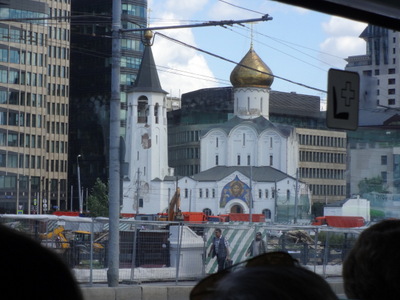 The late-17th church of the Holy Trinity, shown here, was the first golden onion dome we spotted. Like most of my shots in Moscow, this one is full of wires. Except for the overhead wires that power the electric trams and trolley buses, the city does not use power poles. All the wires for electricity, phone, cable TV, etc. are strung chaotically from building to building. The building facades are dotted with window-unit air conditioners, the power cords of which typically run a couple of feet on the outside of the building, then disappear into the wall to connect to a power line. Fortunately, Moscow has embarked on a campaign to change all that. Street by street, they are renovating all the building facades and running all the wires underground, so reasonbly soon, the city will be much improved in appearance. (Now if the U.S. would just do the same thing . . .)
The late-17th church of the Holy Trinity, shown here, was the first golden onion dome we spotted. Like most of my shots in Moscow, this one is full of wires. Except for the overhead wires that power the electric trams and trolley buses, the city does not use power poles. All the wires for electricity, phone, cable TV, etc. are strung chaotically from building to building. The building facades are dotted with window-unit air conditioners, the power cords of which typically run a couple of feet on the outside of the building, then disappear into the wall to connect to a power line. Fortunately, Moscow has embarked on a campaign to change all that. Street by street, they are renovating all the building facades and running all the wires underground, so reasonbly soon, the city will be much improved in appearance. (Now if the U.S. would just do the same thing . . .)
- Lada is the best-known Russian car company, made on the Volga; a couple of other makes used to be produced, but some have been discontinued
- 197, 199, 177, 77, 97, 99 are Moscow-region license-plate-number prefixes
- In a referendum in the 1990's voters in the region voted to change the name of Leningrad back to St. Petersburg, but it was urban voters who favored the change. Rural voters voted not to change, so the region around the city is still called the "Leinigrad Region."
- We passed a statue of Maxim Gorky (a pen name, meaning "beaten"), who died in 1936 of TB despite spending time on Capri, hoping the climate would help. Unfortunately, I couldn't get a good photo. Gorky wrote about working people. The street with his statue used to be Gorky Street but has been changed back to its historical name (in the same trend that changed Leningrad back to St. Petersburg.
- All road work, including the massive amounts of it that were holding up our bus trip, is done in the summer because the ground is frozen hard in the winter.
- The Greek alphabet was devised by Greek monks, and the Cyrillic alphabet is based on it but slightly different. The alphabet came to Russia with the orthodox church and was modified by a monk named Cyril (pronounced "Kiril" in Russian; he was one of the two monks who moved to Russia to establish the church there) to produce the 33 letters of the the Russian alphabet. Many of the letters remain the same as the Greek ones, but by no means all!
- Moscow now has 200 metro stations, and the system is still growing.
Written 22 August 2017
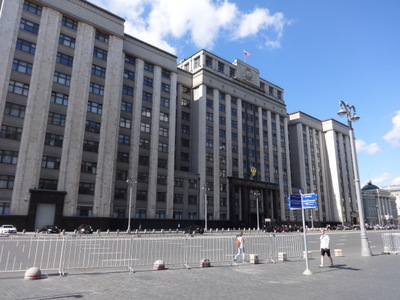
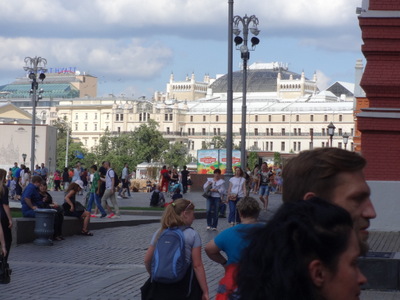 Eventually we arrived in the center of Moscow. We passed right in front of the building (at left) housing the Duma (Russian legislature). The golden symbol over its door is the double-headed eagle, the symbol of the Byzantine empire, which we saw very frequently, throughout the trip. Pointing my telephoto down the street from the spot, a block away, where we were dropped off, I got my first shot of the legendary Metropol hotel (behing the pair of lamp posts, topped by the large oblong glass dome).
Eventually we arrived in the center of Moscow. We passed right in front of the building (at left) housing the Duma (Russian legislature). The golden symbol over its door is the double-headed eagle, the symbol of the Byzantine empire, which we saw very frequently, throughout the trip. Pointing my telephoto down the street from the spot, a block away, where we were dropped off, I got my first shot of the legendary Metropol hotel (behing the pair of lamp posts, topped by the large oblong glass dome).
The red brick building at the right-hand edge of that shot is the State Museum of the History of Moscow, which covers the subject from the stone age to the present.
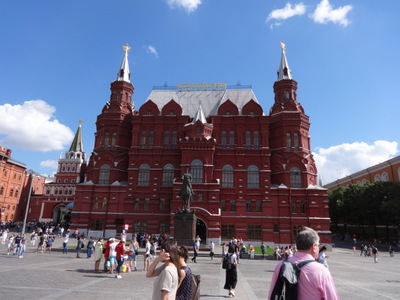
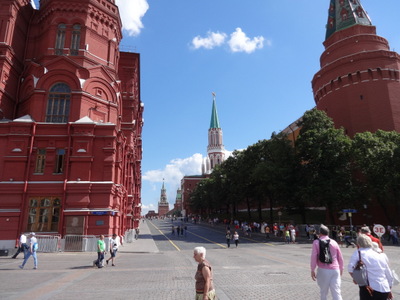 Here's the full frontal view of the state museum. It is built of red brick but gets its actual color from a coat of dark red paint. We never got inside—we saw an awful lot in our 3.5 days in the city, but as in any large city with a long historical and cultural heritage, you just can't see everything. The bronze equestrian statue in front of it is of the general (whose name escapes me just now) who led the Russian forces during World War II. All four of the horse's feet are on the ground, so the general presumably died in bed.
Here's the full frontal view of the state museum. It is built of red brick but gets its actual color from a coat of dark red paint. We never got inside—we saw an awful lot in our 3.5 days in the city, but as in any large city with a long historical and cultural heritage, you just can't see everything. The bronze equestrian statue in front of it is of the general (whose name escapes me just now) who led the Russian forces during World War II. All four of the horse's feet are on the ground, so the general presumably died in bed.
Red Square is a rectangle whose long axis runs NW to SE. The museum building forms its NW boundary. The photo at the right shows the path we took around the right-hand side of the building to the square itself.

 And here is Red Square itself. As you can see, it's not actually red, nor does its name have anything to do with communism. It just means "Beautiful Square."
And here is Red Square itself. As you can see, it's not actually red, nor does its name have anything to do with communism. It just means "Beautiful Square."
One long side (here, the right one) is bounded by the outside wall of the Kremlin (also painted brick), the other (here, the left one) by the gigantic GUM department store. At the far end is St. Basil's cathedral.
In this photo, from right to left along the skyline, you can see the top of the dome and flag of the Old Senate Building and Presidential Residence (inside the Kremlin wall; Putin uses office space there for prefers to live in the suburbs; he commutes in by helicopter, to avoid the terrible traffic); one of the wall's guard towers (this one called the "Senate Tower"); the Savior Tower (another of the wall's guard towers, but much taller than the others and bearing a large clock); Lenin's dark-red marble mausoleum (actually only as far away as the first guard tower and much closer to the camera than St. Basil's; again, we never got inside); St. Basil's cathedral, with its multicolored onion domes; and the long golden-beige facade of GUM.
At the left is a shot of the central entrance to GUM (pronounced "goom"). The name is an acronym for something like "grand central department store." Although it's always called a department store, it's actually what we would call a shopping mall—a huge collection of independent stores under one roof.
The Kremlin wall is about a mile long (ca. 1.5 km), and the space is encloses is roughly triangular and covers 15 acres, perhaps five times the size of Red Square. In the photo of Red Square, you can see a little more than half of one side. Well beyond St. Basil's, the wall make a sharp right turn (as viewed here) and runs along the Moscow River. The third side then runs from the river back up to the point where we walked around the museum to enter Red Square.
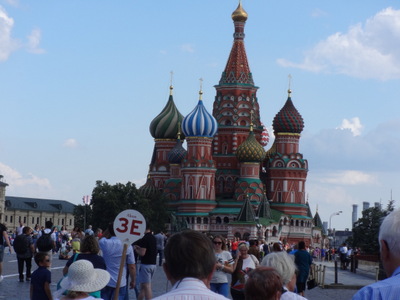
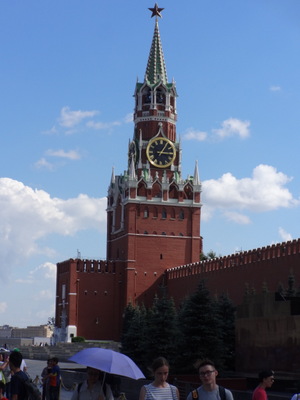 Here's a better view of St. Basil's, and yes, it really looks like that! At the lower left, you can see our local guide's white hat and the "3E" lollipop sign we were following (we were in group 3E for the day). We never went inside St. Basil's; colorful as it is on the outside, it's apparently dark, dingy, and claustrophic inside, so the guides never bother to take tourists there. And in fact, we learned that only one of the domes (perhaps not even one visible from the front), is St. Basil's proper, which is a small chapel. Its official name is "The Cathedral of the Intercession of the Virgin by the Moat," and its construction was commissioned by Ivan IV (the Terrible).
Here's a better view of St. Basil's, and yes, it really looks like that! At the lower left, you can see our local guide's white hat and the "3E" lollipop sign we were following (we were in group 3E for the day). We never went inside St. Basil's; colorful as it is on the outside, it's apparently dark, dingy, and claustrophic inside, so the guides never bother to take tourists there. And in fact, we learned that only one of the domes (perhaps not even one visible from the front), is St. Basil's proper, which is a small chapel. Its official name is "The Cathedral of the Intercession of the Virgin by the Moat," and its construction was commissioned by Ivan IV (the Terrible).
St the right is a better view of the Savior Tower, which I found to be a very useful landmark—you could see it from both inside and outside the Kremlin wall, and the clock distinguished it from all the other towers looming on all sides.
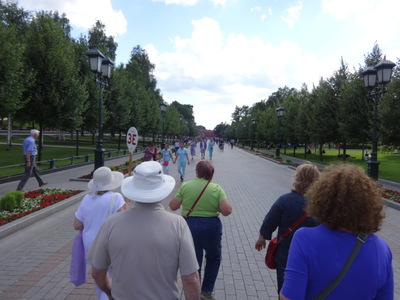
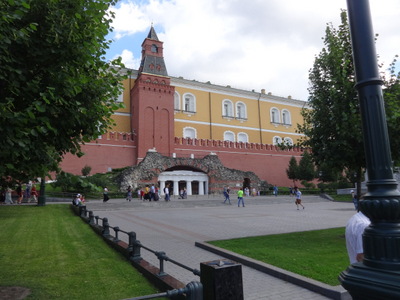 After viewing Red Square, we walked back the way we had come, then turned left to follow the "third" wall toward the entrance to the Kremlin itself. The left-hand photo shows the gardens that run along that wall (the wall itself is just out of sight among the trees to the left). The gardens follow the course of a river that used to run along the wall but that has been enclosed in a large tube and buried. It still flows, but only under ground. That's David just ahead of me in the white Tilley hat, trailing the 3E lollipop.
After viewing Red Square, we walked back the way we had come, then turned left to follow the "third" wall toward the entrance to the Kremlin itself. The left-hand photo shows the gardens that run along that wall (the wall itself is just out of sight among the trees to the left). The gardens follow the course of a river that used to run along the wall but that has been enclosed in a large tube and buried. It still flows, but only under ground. That's David just ahead of me in the white Tilley hat, trailing the 3E lollipop.
At the right is a section of the wall that seems to have been built around some ancient ruins. In reality, the guide explained, some 19th-century princess or other, who walked daily in this garden, got bored with the featureless wall and had some artifical "ruins" incorporated into the section to add visual interest. Behind the white columns is a grotto used as a memorial to the Napoleonic wars. Above the wall, you can see the Old Arsenal building, built in the same style and color scheme as the old Senate building, you could just see the dome of in my view of Red Square
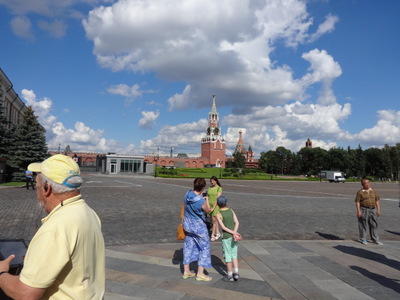
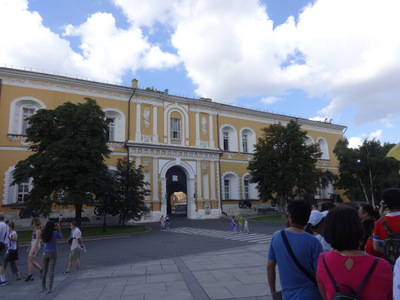 And here we are inside the Kremlin iself. You can see the Savior Tower in the distance and, to the right of it, a couple domes of St. Basil's, so you know Red Square is on the other side of that wall.
And here we are inside the Kremlin iself. You can see the Savior Tower in the distance and, to the right of it, a couple domes of St. Basil's, so you know Red Square is on the other side of that wall.
Here's a view of part of the old Arsenal building, which we could see looming over the wall above the ruins. In addition to buildings in that style and in older stone, one modern glass-and-steel building is used for international rallies. Outside it looks about four stories tall, but the guide said it's larger than it looks—six more stories are under ground.
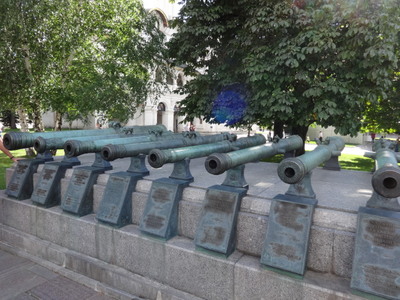
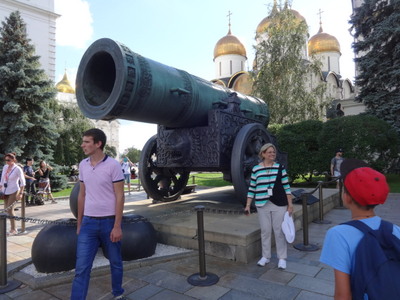 Still inside the Kremlin, we saw this series of old cannons, probably captured from Napoleon. I had to wait a while to get this shot in which no children are straddling them or tourists posing in front of them.
Still inside the Kremlin, we saw this series of old cannons, probably captured from Napoleon. I had to wait a while to get this shot in which no children are straddling them or tourists posing in front of them.
Nearby was the Tsar cannon, which weighs 14 tons and was placed in the Kremlin in the 18th century. When in use, it actually fired grape shot and cannister, so the cannon balls at its foot are only decorative and are, in fact, too large for the bore of the cannon. That's Rachel in the horizonal stripes and the church of the Dormition with the gilded domes in the background.
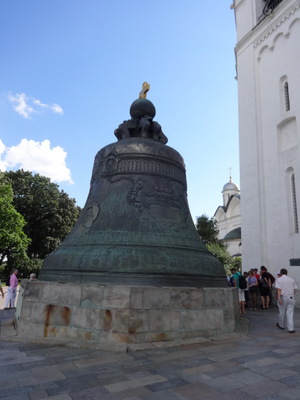
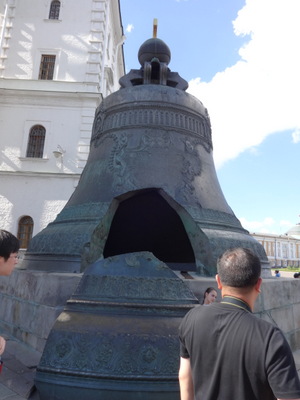 At the left here is the Tsar bell, which weighs 2000 tons. (Whenever the guide said "tons," I write "tons," but bear in mind that at least some of the time the guide may have meant "tonnes," which are heavier than "tons.")
At the left here is the Tsar bell, which weighs 2000 tons. (Whenever the guide said "tons," I write "tons," but bear in mind that at least some of the time the guide may have meant "tonnes," which are heavier than "tons.")
From the other side of the bell, you can see why it was never put into service—the piece that fell out weighs 11 tons (or tonnes?). It was intended for the 17th century Delphian tower right behind where I stood to take the photo. When Empress Anna commissioned the bell and stated that she wanted it to be 10 tons heavier than any other bell, appropriate craftsmen were located and a huge pit was dug in which to cast it. All went well—the bell was cast, hoisted intact from its pit, and placed on massive wooden beams slid under it, right across the mouth of the pit. The craftsmen were still engaged in applying the ornamentation (the garlands and curlicues you can see on the surface) when a fire broke out in the night and burned the building. Well-meaning guards, fearing the fire would overheat and damage the bell, threw cold water on it, at which point it cracked in 11 places, and the chunk fell out. The fire then burned through the beams supporting the bell, and it fell back into its casting pit. And there it sat for 100 years, because nobody could manage to get it out again. Napoleon found it there when he occupied Moscow in 1812 and wanted to take it home as a trophy, but he couldn't get it out either. Finally somebody managed to hoist it out in 1939 and set it on its present pedestal. For a while, it was even used as a chapel; the broken spot was used as the entrance.
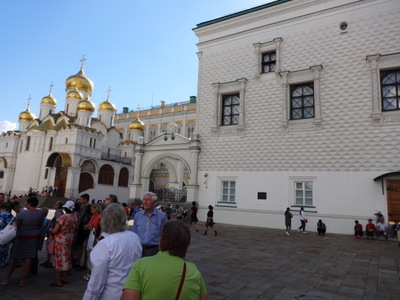
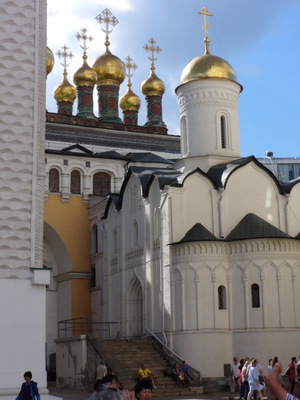 The left-hand photo here shows both the "Faceted Chamber," which has faceted walls, and a long view of the Cathedral of the Annunciation. The Faceted Palace was built by Italians brought in for the purpose, as a party pavilion. Its porch (the arched portion between it and the cathedral is called the "red porch" because (of course) it's beautiful.
The left-hand photo here shows both the "Faceted Chamber," which has faceted walls, and a long view of the Cathedral of the Annunciation. The Faceted Palace was built by Italians brought in for the purpose, as a party pavilion. Its porch (the arched portion between it and the cathedral is called the "red porch" because (of course) it's beautiful.
On the far side of the cathedral, out of sight in this photo, is a second porch, reached by outdoor steps, with a door into the church. It seems that in the Russian Orthodox church, a man may marry only three times, even if all three wives die young. (And in the Russian Orthodox church, a wife who enters a nunnery counts as having died, leaving the man free to marry again as long as she wasn't already the third wife.) Well, Ivan the Terrible's first three wives all died (lasting 13 years, 8 years, and three weeks, respectively), and when he took a fourth, he was punished by an 18-month prohibition against entering a church. His solution was to build that porch, where he could sit or stand with the door open and hear the service without actually entering the church.
He eventually sent that fourth wife, and a fifth, to a nunnery and married at least once after that.
To the right of the Faceted Chamber (you can see the edge of it along the left-hand edge of the right-hand photo) are two more churches (not cathedrals; Nativity with the five small domes and Deposition of the Robe with just one, to the the right).
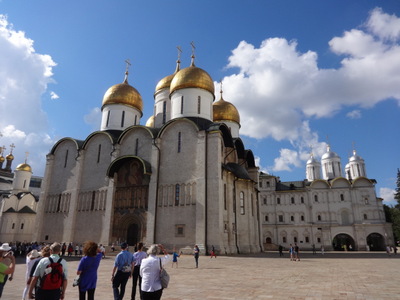
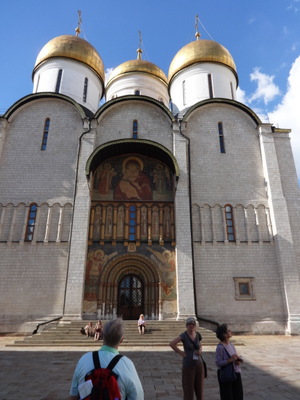 The first cathedral we actually entered was the Cathedral of the Dormition, shown here in longer view and closer up to the facade. Roman Catholics speak of the "Assumption" of the virgin Mary—her ascent to heaven after her death. In the Russian Orthodox church, though, the story is that Mary simply fell asleep and was carried to heaven in that state, so the process is called her "dormition" rather than her "assumption." (And, by the way, she is never known in the Russian church as "Mary," or "The Blessed Virgin," or any of those Catholic names; it is always "the Mother of God."
The first cathedral we actually entered was the Cathedral of the Dormition, shown here in longer view and closer up to the facade. Roman Catholics speak of the "Assumption" of the virgin Mary—her ascent to heaven after her death. In the Russian Orthodox church, though, the story is that Mary simply fell asleep and was carried to heaven in that state, so the process is called her "dormition" rather than her "assumption." (And, by the way, she is never known in the Russian church as "Mary," or "The Blessed Virgin," or any of those Catholic names; it is always "the Mother of God."
The Dormition is the largest cathedral in the Kremlin but is still very small. Russian Orthodox cathedrals are all quite small inside compared to, say, the Roman Catholic cathedrals of France. Inside, again like all Russian churches and cathedrals, it is covered floor to ceiling with icons, mostly gilded ones. Only the tsar, the tsarina, and the patriarch are allowed to sit, so the place has just three pews.
The icon stand (aka wall of icons or iconostasis) divides the "nave" from the "choir," although in Russian churches, the two tend to be about equal in size. The screen is traditionally five tiers high, and the icons in each tier are dedicated to a different class of religious image: saints, disciples, angles, etc. The icon to the left of the central door is always of Mary, the one to the right of Jesus, and the one to Jesus's right to represent whatever that church is dedicated to. The central door is opened only during services, and only the priest can go through.
Unfortunately, no photos were allowed inside. The cathedral houses a large icon of St. George, which is the largest here in Moscow and possibly in Russia the country. St. George (he of the dragon) is the patron saint of Moscow as well as the symbol of England.
The west wall, which you face as you exit, is traditionally painted with scenes of the last judgement, to remind the parishoners of the consequences of sin as they leave the church.
One leaflet was provided in English, but everything in the church is labeled only in Russian.
Napoleon's troops used this cathedral as a stable and stole 5 tons of silver and a bunch of gold from it. After the war, the silver was recovered and cast into the chandelier now used in the cathedral.
In all, this area of the Kremlin, perhaps the size of an American football field or a little wider, is occupied by—in addition to the Faceted Chamber, the Tsar bell, The Tsar Cannon, and two bell towers—three cathedrals and two other churches. Putting domes only on churches is a Byzantine tradition that has been continued here. The color and decorations of the domes are decided locally, case by case. Here in the Kremlin, where so much gold was used, the city had a problem with crows (which like shiny things) stealing the gold leaf off the domes! They therefore invested in a stable of falcons, which fly over the Kremlin every morning before it opens, keeping the place crow-free.
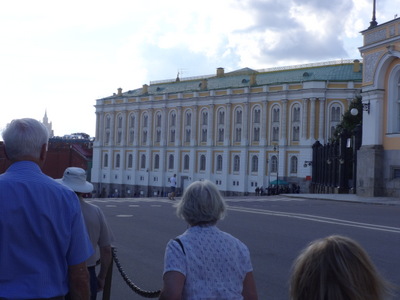
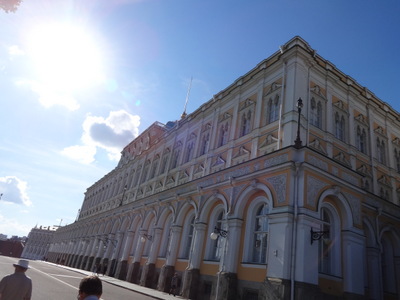 Our group, 3E, consisted of those of us who had chosen the option to view "Treasures of the Kremlin Armory." The regular tour of Red Square and the Kremlin, included in the price of the cruise, allowed time to go into GUM, but we traded that (and a fee) for the chance to visit the armory. The armory is actually inside the Kremlin, against one of the walls, but to get there, we had to go outside the wall, walk farther along the third wall, and reenter by a different gate.
Our group, 3E, consisted of those of us who had chosen the option to view "Treasures of the Kremlin Armory." The regular tour of Red Square and the Kremlin, included in the price of the cruise, allowed time to go into GUM, but we traded that (and a fee) for the chance to visit the armory. The armory is actually inside the Kremlin, against one of the walls, but to get there, we had to go outside the wall, walk farther along the third wall, and reenter by a different gate.
The yellow and white building shown here, which parallels the third wall, across the street from it, used to be a royal residence; now it houses visiting dignitaries.
The Armory Chamber was built by the same architect as the palace and therefore looks like it, but security grills cover the windows. We started by climbing up three flights of stairs and waiting for the group to reassemble. Unfortunately, no photos were allowed in the armory either.
The rooms we visited first, up another half flight of stairs, exhibited clothes—mostly royal costumes and church vestments—including coronation gowns of several of the empresses. The guide explained that everyone wore the same style of clothes, but the higher a person's class, the longer his sleeves, to show that he didn't have to work. Many of the ladies' sleeves reached almost to the ground; they stuck their hands out slits provided for the purpose partway down.
Peter the Great's clothes were particularly impressive. He was 6 feet 8 inches tall, but his feet were so small that he wore two pairs of boots, one over the other, to make them look bigger. He was an amazing guy in many other ways, as will become increasingly clear in these pages.
On the other hand, some of the ladies' gowns were impressively small, and amazingly wasp-waisted. Like Scarlett O'Hara, they sometimes employed a stout maid (or even a couple of stout guardsmen) to plant a knee in their backs and haul on the lacing of their corsets. Like Cher, some even resorted to having a couple of lower ribs surgically removed to facilitate the process.
In the cases, behind some of the clothing, were tapestries, most clearly Russian-made, as they had Cyrillic text woven right into them.
Another room exhibited thrones. The earlier ones were box-like, like the ones in the chateaux of the Loire (where every piece of furniture doubled as a box when the king moved from chateau to chateau). Later were ones curvilinear and upholstered in velvet, with embroidery and brocade. Most were studded with precious stones. Turquoise was popular, but one, called appropriately enough the diamond throne, was studded with a huge number of small diamonds.
Peter the Great and his elder half-brother Ivan, were crowned together on the same day and ruled jointly until Ivan's death (he was always sickly and was never expected to live long; hence the double coronation). They had a double throne ornamented by kilos of silver.
The crown jewels included ornate hats, crowns, collars, sceptors, orbs, and swords, mostly gold with small stones, although with a few impressively large ones. The stones were mostly smooth rather than faceted. The sable fur trim of the hats is replaced every 25 years; the rest are authentic. Catherine the Great had a crown set with hundreds of diamonds, but when she commissioned a larger one, she thriftily had them extract all the diamonds from the old one and reuse them. Both the older denuded crown and the new one with many thousands of diamonds are on display.
Next came a room full of carriages. One was a gift from James I of England to Boris Gudonov (who ruled Russia for a while between Ivan the Terrible, the last of the Rurik dynasty, and Michael Romanov, the first of the Romanov dynasty). Gundonov was not popular because he succeeded a child (Dmitri, younger son of Ivan the Terrible), who was epileptic and supposedly had a seizure in the garden, fell on his own knife, and cut his own throat. People suspected that Boris actually arranged his death. Today we remember Boris Gudonov as (a) the title of an opera by Modest Mussorgsky and (b) the guy whose name "Boris Badenov" (of Rocky and Bullwinkle) is a parody of.
Some of the coaches had impressively large mica windows, but by the time of Catherine the Great, glass was used. She entered Moscow in a huge golden coach. We saw one coach in which eight people could sit around a table inside. It was heated inside by a stove and was pulled by 23 horses (of course, the more horses, the higher the status). Some of the smaller coaches were pulled by troikas of three horses.
Later coaches were lacquered and painted with flowers (including orchids, roses), mythical scenes, and allegorical or historical scenes. One weighed 2 tons, had very lwo clearance, and (we were told wasn't very comfortable.
The next room housed all the ornate horse tack; including brocaded and velvet saddles.
Another room held richly decorated bible covers (some a meter tall), dishes, platters, and icon mountings. At least in Russia, paintings didn't replace large ornate platters as popular wall hangings until the 18th century.
A highlight of the tour was the armory's collection of 10 Fabergé Easter eggs. They are gorgeous, and I'll write more about them in the section on St. Petersburg, but we were very disappointed in the armory's treatment of them. They were all clustered in one single-sided display case, so only about six people could stand in front of them at once, and you couldn't circle around to see the other sides of them. The room was crowded, so it took a while to work your way forward to see them at all, and then you were constantly pressured to move aside to let others through. Too bad.
Eventually we reached the actual armory of the armory, where they kept all the armor and weapons, including chain mail and full suits of horse armor.
Finally, we reached the collection of silver, including a beautiful English-made clock (very small face in the middle of a huge starburst) on top of an ornate cube-shaped base. The armory's collection of English silver, mostly given as diplomatic gifts, is now the best and largest in the world, because Cromwell couldn't get at it.
It includes dozens of silver urns, salt cellars, sweetmeat dishes, platters, censors, adn other objects, and that's just the English items. Many other countries have given silver as diplomatic gifts as well.
Finally we reached the end of the armory tour (though we by no means saw everything there was to see!) and returned to the bus for the next phase of the day—a classical folklore concert. On the bus, we broke out the snacks we'd brought from the ship. Each included a sandwich (the standard pair of triangular halves sealed in a triangular plastic box), a bag of chips, a juice box, and an apple. We all got sour-cream-and-chive chips except Ev, for whom the chef had packed plain ones. (Throughout the trip, the kitchen and the dining room staff were extremely careful and solicitous about Ev's inability to eat onions or garlic.)
[A brief digression about the fate of the left-overs: David and I split a sandwich, so we had a whole one left over. In all, we had the sandwich, one bag of chips, two juice boxes, and three apples left, so we piled all of them into one bag and the trash into another. The bag of left-overs wound up in my stateroom, and no one took me up on offers to share, so the sandwich languished in my mini-fridge until the end of the trip, when I threw it away. I lined the chips, juices, and apples up on the dresser in my room. I ate the chips a couple of days later (they were really good; from the bag, and from later menu entries, I learned that "smetana" is not just the name of the composer of the Moldau and the rest of Ma Vlast but also the Russian word for sour cream), but the juice boxes and apples were still there when we left the ship—we were quite well fed at regular meal times. The day after our picnic, though, I returned to my stateroom after lunch to find that someone (presumably Anastasia, the chambermaid) had put a plate under the apples and added a knife. Viking service really is very thoughtful.]
During the bus ride, the guide pointed out more landmarks. Although many buildings still bear the Byzantine double-headed eagle, red stars are now used instead. The tower with the star nearest the state history museum is the St. Nicholas tower, the tallest tower in the Kremlin (37 m).
We also drove past the Manège (the old riding school), where Tolstoy learned to ride his bicycle. It's now an exhibition hall. (A recurring theme; the vast open spaces inside old riding schools make good exhibition halls.)
In the 1950's, Stalin's built seven high-rises, then the tallest buildings in the city, each topped by a large illuminated red star. One guide told us they were supposed to respresent the seven hills on which Moscow stands, but a later guide revealed that he originally meant to build 10 of them but never finished. They've now been put to a number of different uses.
We also (for the first of several times) the huge statue of Vladimir of Kiev (Christianizer of Russia). Photos of him later.
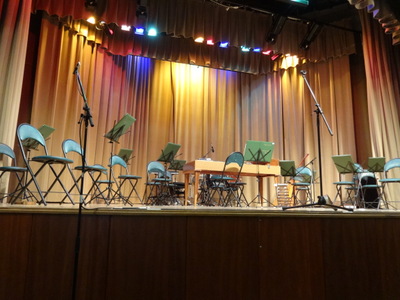
 The concert turned out to be one of the highlights of the trip! We were asked not to take photos, but I figured a shot of the empty stage before the performers appeared was fair. Later, I discovered that David had also sneaked one shot, of the performers at the end, after the last number. The balalaika section is hidden behind the conductor and somebody's head.
The concert turned out to be one of the highlights of the trip! We were asked not to take photos, but I figured a shot of the empty stage before the performers appeared was fair. Later, I discovered that David had also sneaked one shot, of the performers at the end, after the last number. The balalaika section is hidden behind the conductor and somebody's head.
It began with a colorfully costumed old codger who wandered onto the stage and played a couple of folk tunes, slightly off key, on a recorder. When the rest of the musicians came on stage and took their places, he played a note for them to tune to that started (I guess) at A 440 but then wandered at least a half-tone up and down toward the end. Accustomed to the routine, they all managed to tune successfully anyway. The codger then disappeared, and the concert began in earnest. And boy was it good! They played both classical pieces and folk music. At one point, they were joined by a pair of women in colorful peasant costume who sang in that wonderful eastern European shouted harmony that I love so much. At another, an operatic soprano did a couple of numbers. Then a series of solos by orchestra members. The conductor explained that, in a Russian folk orchestra, the domra (a round-bodied instrument in the lute family) is as important as the violin in western orchestras, and the first-chair domra player (standing at left of the right-hand photo) proceeded to prove it by playing one of those hair-raisingly difficult Paganini violin concertos on the domra! She alternated seamlessly between blindingly fast strumming with a pick and individual finger picking, and even though we were in the second row, I never did figure out what she did with the pick in between.
Then a guy came forward with a middle-sized balaika (they had small ones, middle-sized ones, and a huge contra-bass whose lower corner rested on the floor while it was played), then was joined by a second balaika for a duet. I counted 14 players in all, on assorted domras, assorted balaikas, two guslis (a small lap gusli, like a large psaltery, and a table gusli, like a very large horizontal autoharp; the object on legs behind the empty chair), two percussionists, and an accordion. The gusli players also had a solo, as did one of the percussionists, who played a xylophone/marimba sort of thing. To show off, he danced while playing it. (Lawrence Welk used to have a dancer who also played the marimba, and he sometimes did both together; he was a better dancer, but his marimba was not nearly in the same league as the Russian guy's.
Finally the old codger came back on and played numbers on a variety of crude folk instruments (bowed hand saw, a variety of wooden contraptions that put the best spoon players to shame, more recorder), before the whole orchestra played a couple of rousing numbers for the finale. Amazing!
Rachel and I were surprised to learn, for example, that the melody in Lara's theme from Dr. Zhivago is played not, as we had though, on the balaika, but on the domra! If you Google "Moscow folk orchestra," you can find a YouTube video of the group, including the codger.
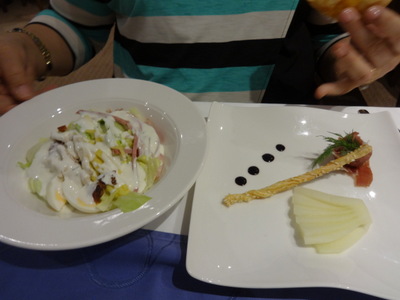
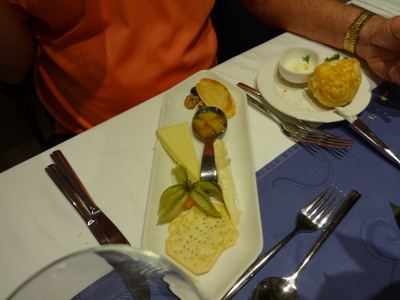 And the day wasn't over yet. When we finally got back to the ship, between 8:30 and 9 p.m., dinner was waiting for us. Rachel had three starters for dinner. (That's one of the joys of a Viking menu—no difficult decisions. If you want more than one appetizer or entré, you just say so. You can order everything on the menu, if you want, just so you can try everything.) At the left is the chef's salad, and to the right of it is a small fanned slice of melon, a little turban of raw ham, and a pastry twig drizzled with honey and sprinkled with sesame seeds. I think the dots were balsamic reduction.
And the day wasn't over yet. When we finally got back to the ship, between 8:30 and 9 p.m., dinner was waiting for us. Rachel had three starters for dinner. (That's one of the joys of a Viking menu—no difficult decisions. If you want more than one appetizer or entré, you just say so. You can order everything on the menu, if you want, just so you can try everything.) At the left is the chef's salad, and to the right of it is a small fanned slice of melon, a little turban of raw ham, and a pastry twig drizzled with honey and sprinkled with sesame seeds. I think the dots were balsamic reduction.
Ev, as usual, started with the cheese plate— on this occasion, Camembert and Emmenthal—which always included spoonful of some house-made fruit chutney, which he usually gave to me or one of the others.
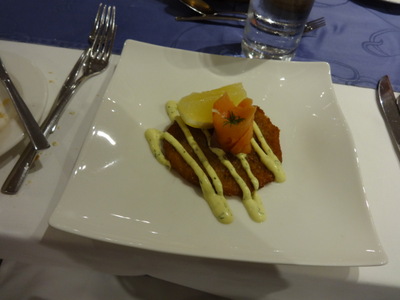
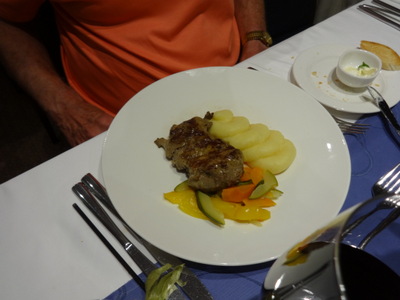 I started with potato fritter and smoked salmon with dill-honey sauce (billed as a Russian specialty). As you can see, the fritter was more of a potato pancake; they showed up on a couple of breakfasts, too, and were tasty but never crisp.
I started with potato fritter and smoked salmon with dill-honey sauce (billed as a Russian specialty). As you can see, the fritter was more of a potato pancake; they showed up on a couple of breakfasts, too, and were tasty but never crisp.
Ev ordered the beef tenderloin from the "always available" menu (always Caesar salad, poached salmon, chicken breast, beef tenderloin), which came with mashed potatoes and veggies.
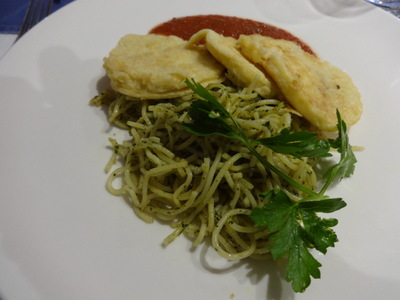
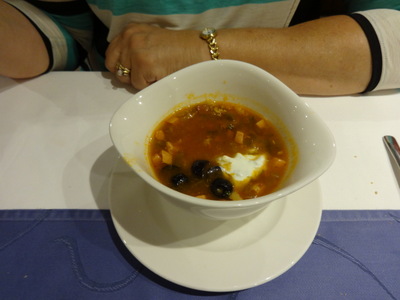 I chose the vegetarian option for my main course—crisp celery root "piccata" over spaghetti with pesto. Slices of celery root were coated in an eggy batter and fried. Very good, but again, not really crisp.
I chose the vegetarian option for my main course—crisp celery root "piccata" over spaghetti with pesto. Slices of celery root were coated in an eggy batter and fried. Very good, but again, not really crisp.
Rachel ordered the fourth appetizer choice as her main course—traditional Moscow-style solyanka soup (beef, sausage, olives, and lemon).
I think David had the roast turkey breast with leek and potato purée. The third entrée choice was filet of daurade royale olive tapenade, which we've had many time in the south of France.
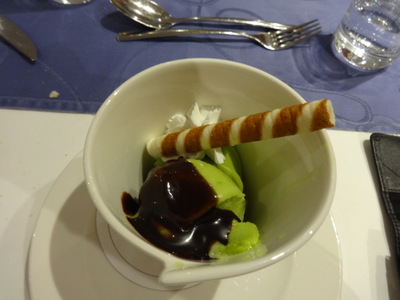
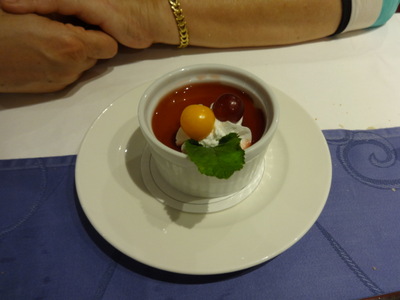 For dessert, no one ordered the pear and walnut tart. I had the sorbet of the day, which was lime, with chocolate sauce, and everyone else had the banana-cinnamon creme with cassis sauce. (An ice cream, a sorbet, and a fresh fruit plate are always available for dessert. They all changed flavors daily. The fruit plate was always just one kind of fruit—fresh plums on this occasion. Chocolate, caramel, and mixed berry sauces are always available, to be combined with any dessert option. I actually am a fan of caramel sauce, but they kept serving ice cream and sorbet flavors that went better with chocolate . . .
For dessert, no one ordered the pear and walnut tart. I had the sorbet of the day, which was lime, with chocolate sauce, and everyone else had the banana-cinnamon creme with cassis sauce. (An ice cream, a sorbet, and a fresh fruit plate are always available for dessert. They all changed flavors daily. The fruit plate was always just one kind of fruit—fresh plums on this occasion. Chocolate, caramel, and mixed berry sauces are always available, to be combined with any dessert option. I actually am a fan of caramel sauce, but they kept serving ice cream and sorbet flavors that went better with chocolate . . .
Previous entry
List of Entries
Next entry

 Great buffet breakfast in the dining room at 7 a.m. (or pastries and coffee from the coffee station or in the Sky Bar from 6 a.m.). Whole apples, bananas, and peaches (above). Wide variety of breads and buns (sliced and whole; pullman bread; bagels, plus a toaster); miniature viennoiseries (pain au chocolate, cocoa spirals, tiny croissants, little fruit bear-claws) and marble pound cake; platter of thick slices of smoked salmon with cream cheese, capers, red onion, pickles, and lemon wedges; cold cuts including raw ham, roast pork (or turkey?), olive loaf, and salami; three whole cheeses (camembert, a soft buttery thing with small eyes, and a smoked-looking thing) and a sliced swiss; fresh diced watermelon, pinapple, and (mirabile dictu!) canary melon; three cold cereals (yellow flakes, chocolate flakes, and cheerio-like rings) and hot oatmeal with milk and a variety of nuts and fresh and dried fruit to sprinkle on (including flax seed); fresh yogurt with and without fruit compote; two jams made on board (blueberry and raspberry, I think) plus "diet" jam; peanut butter; sliced tomatoes, bell peppers, zucchini, and onions.
Great buffet breakfast in the dining room at 7 a.m. (or pastries and coffee from the coffee station or in the Sky Bar from 6 a.m.). Whole apples, bananas, and peaches (above). Wide variety of breads and buns (sliced and whole; pullman bread; bagels, plus a toaster); miniature viennoiseries (pain au chocolate, cocoa spirals, tiny croissants, little fruit bear-claws) and marble pound cake; platter of thick slices of smoked salmon with cream cheese, capers, red onion, pickles, and lemon wedges; cold cuts including raw ham, roast pork (or turkey?), olive loaf, and salami; three whole cheeses (camembert, a soft buttery thing with small eyes, and a smoked-looking thing) and a sliced swiss; fresh diced watermelon, pinapple, and (mirabile dictu!) canary melon; three cold cereals (yellow flakes, chocolate flakes, and cheerio-like rings) and hot oatmeal with milk and a variety of nuts and fresh and dried fruit to sprinkle on (including flax seed); fresh yogurt with and without fruit compote; two jams made on board (blueberry and raspberry, I think) plus "diet" jam; peanut butter; sliced tomatoes, bell peppers, zucchini, and onions.
 It was raining lightly when I got up but has since (at 11 a.m.) brightened up and mostly cleared. My stateroom was on the side facing the quai, so I had hoped to have a view of Moscow, but as it happened, the ship was moored almost an hour's drive from th middle of town, and in addition the quai was separated from the nearest street by a wide band of park, so this (left) is what I saw—park, a wrought-iron fence, and parked tour buses (which came and went). Occasionally, I could see picknickers through the trees, up at the level of the roofs of the buses, where ground level of the park was.
It was raining lightly when I got up but has since (at 11 a.m.) brightened up and mostly cleared. My stateroom was on the side facing the quai, so I had hoped to have a view of Moscow, but as it happened, the ship was moored almost an hour's drive from th middle of town, and in addition the quai was separated from the nearest street by a wide band of park, so this (left) is what I saw—park, a wrought-iron fence, and parked tour buses (which came and went). Occasionally, I could see picknickers through the trees, up at the level of the roofs of the buses, where ground level of the park was.

 Chafing dishes of scrambled eggs (good), sausages (bad; essentially little wieners), "poultry" sausage (which I haven't tried yet), bacon, cooked mushrooms, potatoes (undercooked), and sautéed zucchini; tiny glass jars of mustard, ketchup, and mayo; and a complete, manned omelet station with many adjuvants. Orange and cranberry juices; coffee, tea, and chocolate. On the tables are orange marmalade, cherry jam, strawberry jam, honey, and butter. Yummy.
Chafing dishes of scrambled eggs (good), sausages (bad; essentially little wieners), "poultry" sausage (which I haven't tried yet), bacon, cooked mushrooms, potatoes (undercooked), and sautéed zucchini; tiny glass jars of mustard, ketchup, and mayo; and a complete, manned omelet station with many adjuvants. Orange and cranberry juices; coffee, tea, and chocolate. On the tables are orange marmalade, cherry jam, strawberry jam, honey, and butter. Yummy.
 After breakfast, a leisurely morning, punctuated only by the 10 a.m. life-jacket drill. A gentle alarm (at first, I thought it was a phone ringing in the stateroom next door) signalled us to report to our cabins and don our life jackets, use of which had been demonstrated at the previous day's briefing. Then the same alarm, ringing in a pattern (indicating "abandon ship"), signalled us to stand outside our stateroom doors waiting to be inspected. It was apparently very important to tie your life jacket with a bow of only one loop (our inspector didn't have enough English to explain why). Then more leisure time until lunch.
After breakfast, a leisurely morning, punctuated only by the 10 a.m. life-jacket drill. A gentle alarm (at first, I thought it was a phone ringing in the stateroom next door) signalled us to report to our cabins and don our life jackets, use of which had been demonstrated at the previous day's briefing. Then the same alarm, ringing in a pattern (indicating "abandon ship"), signalled us to stand outside our stateroom doors waiting to be inspected. It was apparently very important to tie your life jacket with a bow of only one loop (our inspector didn't have enough English to explain why). Then more leisure time until lunch.
 Lunch began each day with the appetizer buffet/salad bar, which featured two items listed on the menu as the official "appetizers" (on this day, huge cold green-lipped mussels topped with a vegetable salsa (on little individual plates in the foreground) and a chafing dish of braised bbq spare ribs), typically three mixed salads (here kidney beans with tomatoes, cucumber, and bits of boiled ham; carrot and cabbage slaw; and bell peppers with mushrooms) and three kinds of plain chopped vegetables (here cucumbers, carrots, and tomatoes), as well as three different bowls of chopped salad greens and fresh whole fruit.
Lunch began each day with the appetizer buffet/salad bar, which featured two items listed on the menu as the official "appetizers" (on this day, huge cold green-lipped mussels topped with a vegetable salsa (on little individual plates in the foreground) and a chafing dish of braised bbq spare ribs), typically three mixed salads (here kidney beans with tomatoes, cucumber, and bits of boiled ham; carrot and cabbage slaw; and bell peppers with mushrooms) and three kinds of plain chopped vegetables (here cucumbers, carrots, and tomatoes), as well as three different bowls of chopped salad greens and fresh whole fruit.
 The buffet also included a pasta station featuring a different pasta dish each day (here Bolognese) and small ready-made salads (in this case with an Asia-style mix with chicken, snow peaks, lettuce, and carrots with a ginger dressing).
The buffet also included a pasta station featuring a different pasta dish each day (here Bolognese) and small ready-made salads (in this case with an Asia-style mix with chicken, snow peaks, lettuce, and carrots with a ginger dressing).
 On this day Rachel and I had Traditional Russian Goluptsi (cabbage rolls stuffed with meat, braised in tomato sauce) with mashed potato. David had the pasta, and I think Ev chose the Albacore Tuna Melt, hold the onion, with radish and watermelon salad and potato chips. The other choice was lentil soup with bacon, carrots, and celery.
On this day Rachel and I had Traditional Russian Goluptsi (cabbage rolls stuffed with meat, braised in tomato sauce) with mashed potato. David had the pasta, and I think Ev chose the Albacore Tuna Melt, hold the onion, with radish and watermelon salad and potato chips. The other choice was lentil soup with bacon, carrots, and celery.
 Then it was time for our afternoon tour of Red Square, the Kremlin, and Treasures of the Kremlin Armory.
Then it was time for our afternoon tour of Red Square, the Kremlin, and Treasures of the Kremlin Armory. Moscow has 9 railway stations, leading, like the ones in Paris, off in different directions. We drove past the Byeloruski station, shown here at the right, several times.
Moscow has 9 railway stations, leading, like the ones in Paris, off in different directions. We drove past the Byeloruski station, shown here at the right, several times.
 The late-17th church of the Holy Trinity, shown here, was the first golden onion dome we spotted. Like most of my shots in Moscow, this one is full of wires. Except for the overhead wires that power the electric trams and trolley buses, the city does not use power poles. All the wires for electricity, phone, cable TV, etc. are strung chaotically from building to building. The building facades are dotted with window-unit air conditioners, the power cords of which typically run a couple of feet on the outside of the building, then disappear into the wall to connect to a power line. Fortunately, Moscow has embarked on a campaign to change all that. Street by street, they are renovating all the building facades and running all the wires underground, so reasonbly soon, the city will be much improved in appearance. (Now if the U.S. would just do the same thing . . .)
The late-17th church of the Holy Trinity, shown here, was the first golden onion dome we spotted. Like most of my shots in Moscow, this one is full of wires. Except for the overhead wires that power the electric trams and trolley buses, the city does not use power poles. All the wires for electricity, phone, cable TV, etc. are strung chaotically from building to building. The building facades are dotted with window-unit air conditioners, the power cords of which typically run a couple of feet on the outside of the building, then disappear into the wall to connect to a power line. Fortunately, Moscow has embarked on a campaign to change all that. Street by street, they are renovating all the building facades and running all the wires underground, so reasonbly soon, the city will be much improved in appearance. (Now if the U.S. would just do the same thing . . .)

 Eventually we arrived in the center of Moscow. We passed right in front of the building (at left) housing the Duma (Russian legislature). The golden symbol over its door is the double-headed eagle, the symbol of the Byzantine empire, which we saw very frequently, throughout the trip. Pointing my telephoto down the street from the spot, a block away, where we were dropped off, I got my first shot of the legendary Metropol hotel (behing the pair of lamp posts, topped by the large oblong glass dome).
Eventually we arrived in the center of Moscow. We passed right in front of the building (at left) housing the Duma (Russian legislature). The golden symbol over its door is the double-headed eagle, the symbol of the Byzantine empire, which we saw very frequently, throughout the trip. Pointing my telephoto down the street from the spot, a block away, where we were dropped off, I got my first shot of the legendary Metropol hotel (behing the pair of lamp posts, topped by the large oblong glass dome).

 Here's the full frontal view of the state museum. It is built of red brick but gets its actual color from a coat of dark red paint. We never got inside—we saw an awful lot in our 3.5 days in the city, but as in any large city with a long historical and cultural heritage, you just can't see everything. The bronze equestrian statue in front of it is of the general (whose name escapes me just now) who led the Russian forces during World War II. All four of the horse's feet are on the ground, so the general presumably died in bed.
Here's the full frontal view of the state museum. It is built of red brick but gets its actual color from a coat of dark red paint. We never got inside—we saw an awful lot in our 3.5 days in the city, but as in any large city with a long historical and cultural heritage, you just can't see everything. The bronze equestrian statue in front of it is of the general (whose name escapes me just now) who led the Russian forces during World War II. All four of the horse's feet are on the ground, so the general presumably died in bed.
 And here is Red Square itself. As you can see, it's not actually red, nor does its name have anything to do with communism. It just means "Beautiful Square."
And here is Red Square itself. As you can see, it's not actually red, nor does its name have anything to do with communism. It just means "Beautiful Square."
 Here's a better view of St. Basil's, and yes, it really looks like that! At the lower left, you can see our local guide's white hat and the "3E" lollipop sign we were following (we were in group 3E for the day). We never went inside St. Basil's; colorful as it is on the outside, it's apparently dark, dingy, and claustrophic inside, so the guides never bother to take tourists there. And in fact, we learned that only one of the domes (perhaps not even one visible from the front), is St. Basil's proper, which is a small chapel. Its official name is "The Cathedral of the Intercession of the Virgin by the Moat," and its construction was commissioned by Ivan IV (the Terrible).
Here's a better view of St. Basil's, and yes, it really looks like that! At the lower left, you can see our local guide's white hat and the "3E" lollipop sign we were following (we were in group 3E for the day). We never went inside St. Basil's; colorful as it is on the outside, it's apparently dark, dingy, and claustrophic inside, so the guides never bother to take tourists there. And in fact, we learned that only one of the domes (perhaps not even one visible from the front), is St. Basil's proper, which is a small chapel. Its official name is "The Cathedral of the Intercession of the Virgin by the Moat," and its construction was commissioned by Ivan IV (the Terrible). 
 After viewing Red Square, we walked back the way we had come, then turned left to follow the "third" wall toward the entrance to the Kremlin itself. The left-hand photo shows the gardens that run along that wall (the wall itself is just out of sight among the trees to the left). The gardens follow the course of a river that used to run along the wall but that has been enclosed in a large tube and buried. It still flows, but only under ground. That's David just ahead of me in the white Tilley hat, trailing the 3E lollipop.
After viewing Red Square, we walked back the way we had come, then turned left to follow the "third" wall toward the entrance to the Kremlin itself. The left-hand photo shows the gardens that run along that wall (the wall itself is just out of sight among the trees to the left). The gardens follow the course of a river that used to run along the wall but that has been enclosed in a large tube and buried. It still flows, but only under ground. That's David just ahead of me in the white Tilley hat, trailing the 3E lollipop.
 And here we are inside the Kremlin iself. You can see the Savior Tower in the distance and, to the right of it, a couple domes of St. Basil's, so you know Red Square is on the other side of that wall.
And here we are inside the Kremlin iself. You can see the Savior Tower in the distance and, to the right of it, a couple domes of St. Basil's, so you know Red Square is on the other side of that wall.
 Still inside the Kremlin, we saw this series of old cannons, probably captured from Napoleon. I had to wait a while to get this shot in which no children are straddling them or tourists posing in front of them.
Still inside the Kremlin, we saw this series of old cannons, probably captured from Napoleon. I had to wait a while to get this shot in which no children are straddling them or tourists posing in front of them.
 At the left here is the Tsar bell, which weighs 2000 tons. (Whenever the guide said "tons," I write "tons," but bear in mind that at least some of the time the guide may have meant "tonnes," which are heavier than "tons.")
At the left here is the Tsar bell, which weighs 2000 tons. (Whenever the guide said "tons," I write "tons," but bear in mind that at least some of the time the guide may have meant "tonnes," which are heavier than "tons.")
 The left-hand photo here shows both the "Faceted Chamber," which has faceted walls, and a long view of the Cathedral of the Annunciation. The Faceted Palace was built by Italians brought in for the purpose, as a party pavilion. Its porch (the arched portion between it and the cathedral is called the "red porch" because (of course) it's beautiful.
The left-hand photo here shows both the "Faceted Chamber," which has faceted walls, and a long view of the Cathedral of the Annunciation. The Faceted Palace was built by Italians brought in for the purpose, as a party pavilion. Its porch (the arched portion between it and the cathedral is called the "red porch" because (of course) it's beautiful. 
 The first cathedral we actually entered was the Cathedral of the Dormition, shown here in longer view and closer up to the facade. Roman Catholics speak of the "Assumption" of the virgin Mary—her ascent to heaven after her death. In the Russian Orthodox church, though, the story is that Mary simply fell asleep and was carried to heaven in that state, so the process is called her "dormition" rather than her "assumption." (And, by the way, she is never known in the Russian church as "Mary," or "The Blessed Virgin," or any of those Catholic names; it is always "the Mother of God."
The first cathedral we actually entered was the Cathedral of the Dormition, shown here in longer view and closer up to the facade. Roman Catholics speak of the "Assumption" of the virgin Mary—her ascent to heaven after her death. In the Russian Orthodox church, though, the story is that Mary simply fell asleep and was carried to heaven in that state, so the process is called her "dormition" rather than her "assumption." (And, by the way, she is never known in the Russian church as "Mary," or "The Blessed Virgin," or any of those Catholic names; it is always "the Mother of God."
 Our group, 3E, consisted of those of us who had chosen the option to view "Treasures of the Kremlin Armory." The regular tour of Red Square and the Kremlin, included in the price of the cruise, allowed time to go into GUM, but we traded that (and a fee) for the chance to visit the armory. The armory is actually inside the Kremlin, against one of the walls, but to get there, we had to go outside the wall, walk farther along the third wall, and reenter by a different gate.
Our group, 3E, consisted of those of us who had chosen the option to view "Treasures of the Kremlin Armory." The regular tour of Red Square and the Kremlin, included in the price of the cruise, allowed time to go into GUM, but we traded that (and a fee) for the chance to visit the armory. The armory is actually inside the Kremlin, against one of the walls, but to get there, we had to go outside the wall, walk farther along the third wall, and reenter by a different gate.
 The concert turned out to be one of the highlights of the trip! We were asked not to take photos, but I figured a shot of the empty stage before the performers appeared was fair. Later, I discovered that David had also sneaked one shot, of the performers at the end, after the last number. The balalaika section is hidden behind the conductor and somebody's head.
The concert turned out to be one of the highlights of the trip! We were asked not to take photos, but I figured a shot of the empty stage before the performers appeared was fair. Later, I discovered that David had also sneaked one shot, of the performers at the end, after the last number. The balalaika section is hidden behind the conductor and somebody's head.
 And the day wasn't over yet. When we finally got back to the ship, between 8:30 and 9 p.m., dinner was waiting for us. Rachel had three starters for dinner. (That's one of the joys of a Viking menu—no difficult decisions. If you want more than one appetizer or entré, you just say so. You can order everything on the menu, if you want, just so you can try everything.) At the left is the chef's salad, and to the right of it is a small fanned slice of melon, a little turban of raw ham, and a pastry twig drizzled with honey and sprinkled with sesame seeds. I think the dots were balsamic reduction.
And the day wasn't over yet. When we finally got back to the ship, between 8:30 and 9 p.m., dinner was waiting for us. Rachel had three starters for dinner. (That's one of the joys of a Viking menu—no difficult decisions. If you want more than one appetizer or entré, you just say so. You can order everything on the menu, if you want, just so you can try everything.) At the left is the chef's salad, and to the right of it is a small fanned slice of melon, a little turban of raw ham, and a pastry twig drizzled with honey and sprinkled with sesame seeds. I think the dots were balsamic reduction.
 I started with potato fritter and smoked salmon with dill-honey sauce (billed as a Russian specialty). As you can see, the fritter was more of a potato pancake; they showed up on a couple of breakfasts, too, and were tasty but never crisp.
I started with potato fritter and smoked salmon with dill-honey sauce (billed as a Russian specialty). As you can see, the fritter was more of a potato pancake; they showed up on a couple of breakfasts, too, and were tasty but never crisp. 
 I chose the vegetarian option for my main course—crisp celery root "piccata" over spaghetti with pesto. Slices of celery root were coated in an eggy batter and fried. Very good, but again, not really crisp.
I chose the vegetarian option for my main course—crisp celery root "piccata" over spaghetti with pesto. Slices of celery root were coated in an eggy batter and fried. Very good, but again, not really crisp.
 For dessert, no one ordered the pear and walnut tart. I had the sorbet of the day, which was lime, with chocolate sauce, and everyone else had the banana-cinnamon creme with cassis sauce. (An ice cream, a sorbet, and a fresh fruit plate are always available for dessert. They all changed flavors daily. The fruit plate was always just one kind of fruit—fresh plums on this occasion. Chocolate, caramel, and mixed berry sauces are always available, to be combined with any dessert option. I actually am a fan of caramel sauce, but they kept serving ice cream and sorbet flavors that went better with chocolate . . .
For dessert, no one ordered the pear and walnut tart. I had the sorbet of the day, which was lime, with chocolate sauce, and everyone else had the banana-cinnamon creme with cassis sauce. (An ice cream, a sorbet, and a fresh fruit plate are always available for dessert. They all changed flavors daily. The fruit plate was always just one kind of fruit—fresh plums on this occasion. Chocolate, caramel, and mixed berry sauces are always available, to be combined with any dessert option. I actually am a fan of caramel sauce, but they kept serving ice cream and sorbet flavors that went better with chocolate . . .